The Land Across the Jordan River – Part 2
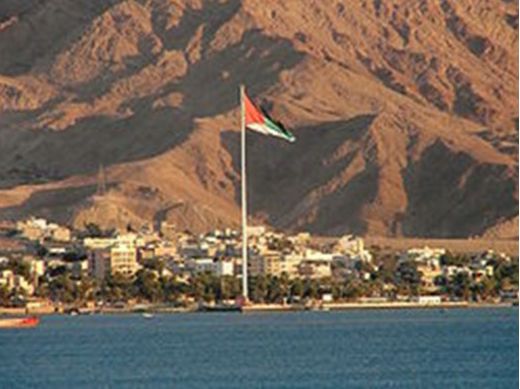
Today’s blog is longer than usual, and I will only dust the surface of how modern-day Jordan came to be. For a look at this part of the world’s ancient history, see last week’s blog.
For those of you who don’t care for what happened in the past, maybe you’ll want to skip this chapter. Being a historyphile (if there is such a word), I revel in what came before us, because I know that history repeats over and over. Sometimes we learn from it; most of the time, we don’t.
The only way to have an understanding of what kind of country Jordan is and why it is that way is to delve into how it came to be. Its first three rulers—Abdullah I, Hussein, and Abdullah II—can take the lion’s share of the credit for being forward-lookers and making it the country it is today.
The Ottoman rule pretty much neglected what is now Jordan, showing up to collect taxes and that was about it. In the 19th century, the population declined because of this neglect and oppression. There were a handful of urban areas, but they couldn’t grow because the Bedouin, who made up the majority of inhabitants, raided them as their source of income. The city-dwellers had to bribe pay them to leave them alone.
The Ottoman rule over Transjordan (1516-1918) came to an end after World War I through the efforts of the Hashemite Army of the Great Arab Revolt. The region’s local Bedouin tribes, Circassians, and Christians helped in the effort. Of course, Great Britain had a little to do with it.
On a side note, I had never heard of the Circassians (Sur-CASH-ins), so I did a little research and found that they lived in the Caucasus Mountains of southern Russia. For those who are familiar with the patterns of tracking the Ten Tribes, you will recognize the Caucasus as a place where they lived at one point in history. The Circassians were Christian for 1,000 years but were Islamized between the 16th and 19th centuries.
Between the Caucasian War and deportation, more than 90 percent of the population disappeared from their homeland. The Ottoman Authorities directed the Circassian immigrants to settle in Jordan, where 20,000 to 80,000 live today. Two groups settled farther south in the Ottoman land holdings in what is today modern Israel. Their 4,000 descendants still live in two towns in the Galilee and are the only Sunni Muslims in the land. They send their sons to the Israeli Defense Forces (IDF).[1]
WHO WERE/ARE THE HASHEMITES?
The leader of the Hashemites, Sharif (Sha-REEF) Hussein of Mecca, launched the Arab Revolt at the encouragement of the British. He had a dream of a united Arab state from Syria to Yemen with him at the helm. Arab nationalism emerged from the resentment of the heavy-handed Ottoman authorities. The allies of World War I, including Britain and France, supported this move and helped.
Sharif Hussein claimed he was the 37th generation from the great-grandfather of Muhammad, the prophet of Islam. So, the family says they are direct descendants. They have ruled Mecca continuously from the tenth century until their conquest by the House of Saud in 1924.[2]
Let’s try to simplify this lineage:
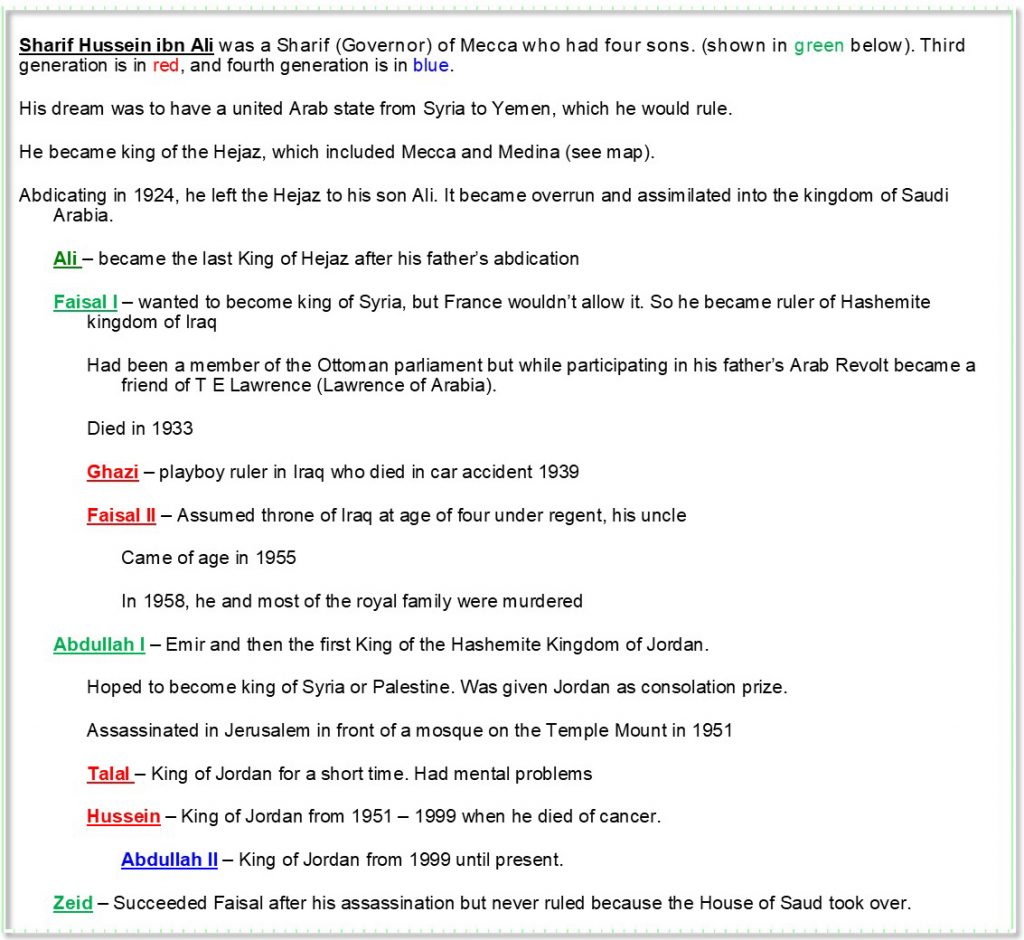
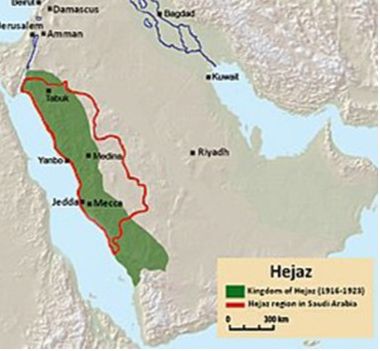
British imperialism dominates Jordan’s history before the Arab Revolt of 1914. After the end of World War I, Britain and France redrew the borders of the Middle East. For more information on the details of this action, look up the Sykes-Picot Agreement. The French wound up with a mandate for Syria and the British with Palestine. We can lay many of today’s Middle East problems to this exercise. You’ve gotta love political intrigue.
Lots of promises were made. Not many were fulfilled.
CHURCHILL CREATED JORDAN
It has been said that Winston Churchill created Jordan. Between August 1920 and February 1921, Transjordan was no man’s land— no ruler and no colonial power. The population was 200,000—almost half of which was nomadic Bedouin. No one wanted the ungovernable land of extreme poverty, sparse population, and seemingly no natural resources. The British wanted no connection between it and their mandate of Palestine. They planned for it to be a staging area of returning people going into Palestine. No one had any plans that it would become a state itself. Finally, they did send six junior political officers to be advisors during this time, but they had no authority.
By February 1921, however, the British government concluded “[Abdullah’s] influence has now completely replaced that of the local governments and of the British advisers in Trans-Jordania.”[3] So they decided to take a back seat and let him deal with the tribes.
As an aside, for a very informative read about what was called “The national Government of Moab” (1920-21) go to this link:
No one wanted the ungovernable land of extreme poverty, sparse population, and seemingly no natural resources.
Faisal I, the son of Sharif Hussein, wanted to rule Syria, but the French would not allow it. So he was given Iraq to rule. Rulers had been doled out to all the countries in the Middle East, and nothing was left for Abdullah I except for a piece of real estate no one wanted—Transjordan, the area east of the Jordan River and the then-named Palestine. In frustration and hatred toward the French who had control over the land the Hashemites were supposed to have, Abdullah put together a small force of tribal Arabs and threatened to carry out raids against them. In an effort to contain the situation, Winston Churchill himself met with Abdullah in Jerusalem and installed him as King of Jordan. In effect, you could say Churchill created Jordan.[4]
Emir Abdullah’s most serious problems stemmed from the repeated Wahhabi incursions from what became Saudi Arabia. Wahabism started in the 16th century with the goal of restoring Islam to its spiritual beginnings. It is very restrictive. Think of present-day Saudi Arabia, and you get the idea. The raids overwhelmed Abdullah’s resources, so Britain installed a military base and small air force close to Amman.
It seems that Britain’s goal was not to rule Transjordan, but to help it become autonomous with a little help. By 1928 it gave King Abdullah full autonomy but continued to provide security through the RAF.
A TWENTY-YEAR STRUGGLE
Without getting into lots of history and dates, which sometimes lulls folks to sleep, let’s just say that for twenty-odd years Transjordan/Jordan struggled along to make its way among the countries of the world.
President Truman crafted a balanced policy between Israel and its moderate Hashemite neighbours when he simultaneously extended formal recognition to the newly created state of Israel and the Kingdom of Transjordan. These two nations were inevitably linked in the President’s mind as twin emergent states: one serving the needs of the refugee Jew, the other absorbing recently displaced Palestinian ArabsClea Lutz Bunch
During the late 1940s, US President Truman recognized both Israel and Jordan. Clea Bunch said that “President Truman crafted a balanced policy between Israel and its moderate Hashemite neighbours when he simultaneously extended formal recognition to the newly created state of Israel and the Kingdom of Transjordan. These two nations were inevitably linked in the President’s mind as twin emergent states: one serving the needs of the refugee Jew, the other absorbing recently displaced Palestinian Arabs. In addition, Truman was aware of the private agreements that existed between Jewish Agency leaders and King Abdullah I of Jordan. Thus, it made perfect sense to Truman to favour both states with de jure recognition.”[5]
Jordan wanted the region where many Palestinians were living to be part of its country, so on April 24, 1950, it formally annexed the West Bank (including East Jerusalem) declaring complete unity between the two sides of the Jordan and their union in one state. . .at whose head reigns King Abdullah ibn al Hussain.”[6]
TROUBLE WITH ITS ARAB BROTHERS
Unfortunately, Jordan signed a mutual-defense pact with Egypt in May 1967, which led to its participating in the Six-Day War the next month. That resulted in Israel’s taking control of East Jerusalem and the West Bank. Palestinian refugees flooded into Jordan—300,000 of them—bringing the total Palestinian population in Jordan to one million.[7]
Jordan has always had to walk a tightrope between its Arab brothers and the West. Hoping to wean Jordan from the “imperialists,” other Arab states offered to replace British financial aid. Jordan took them up on it and rescinded its longstanding treaty with the British in 1957. Egypt, Syria, and Saudi Arabia began to provide the much-needed financial aid.
AMERICA BECOMES JORDAN’S FRIEND AND ALLY
Unfortunately, those countries were ruled by revolutionary regimes, and the conservative monarchy of King Hussein did not get along well with them. They were allied with the Soviet Union and pursued socialist, anti-Western, Pan-Arab agendas. Some elements within his own country began to plot against him to replace him with a republic that would be part of Egyptian President Nasser’s vision. Hussein was forced into putting down a series of internal revolts in April 1957, prompting the US to send the Sixth Fleet to Lebanon, announcing America considered Jordan’s integrity of its vital interest and would provide financial aid to the government.
This did not sit well with the Arab states, which shut off their aid. America replaced the funds and from that time on became Jordan’s principal ally.[8] Maybe it’s because they are in our debt, but I can attest to the fact that they are extremely friendly toward Americans. Everywhere we went, they stopped us on the street asking, “Where you from?” When we replied, “America,” they smiled and said, “Welcome, welcome.”
BORDER CHANGE
In 1965 Jordan and Saudi Arabia concluded a bilateral agreement that realigned the border resulting in exchange of some small territory. Jordan’s coastline on the Gulf of Aqaba was lengthened by about eleven miles. The new boundary enabled Jordan to expand its port facilities and established a zone in which the two parties agreed to share petroleum revenues equally if oil were discovered. The ASEZA Zone (Aqaba Special Economic Zone Authority) today is a tax-free zone on incoming goods. It is much more than that and is designed to make this area attractive to tourism, industry, business interests, natural resources, etc.
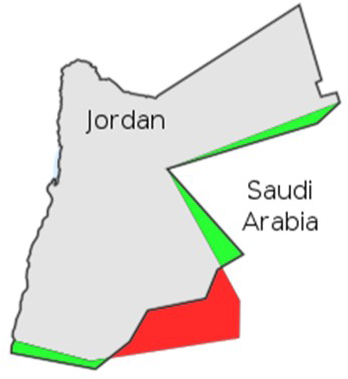
Saudi Arabia gave the green area to Jordan, and Jordan gave Saudi Arabia the red area.
Hussein also hoped to regain the West Bank territory for Jordan, but finally gave up in the wake of the violence during the first intifada. In July 1988, he formally renounced his claim to the area.[9]
1994 TREATY WITH ISRAEL
After the Palestinians signed the Oslo accords, it paved the way for him to negotiate a separate agreement with Israel. Once it was clear that he would not be viewed as betraying the Palestinian cause and would not provoke an upheaval within Jordan, he quickly negotiated a treaty with Israel, which was signed in 1994. Since that time, Jordan and Israel have enjoyed good relations though, as was the case in Egypt, the grand vision of most Israelis for large-scale trade, tourism, and other joint ventures has yet to materialize.[10]
HOW JORDAN BECAME A STABLE NATION
The modern history of Jordan is complex, and I am not sure I have simplified it in this blog. It stands alone in marked contrast as the most moderate of all Middle Eastern countries. Because Britain took a different tact than it had with all the other countries it colonized, Jordan was successful in becoming a stable nation in the midst of chaos.
Britain, the Bedouin tribes, and Abdullah combined efforts to make Jordan into a nation. Abdullah knew how to work with the tribal governments, and Britain worked silently in the background.
At this time in history, since her soldiers had fought alongside the Arabs in their struggle for independence, Britain had an inclination for:
- Non-confrontational policies
- Subtle intervention
- Low visibility of their rule
- Preference for operating behind the scenes through the Emir’s office[11]
State authorities managed to integrate the tribes into the structure of the modern state and turned them into loyal citizens who fully participated in the political process.[12] It allowed tribes to carve out a political rule for themselves within the framework of the modern state.[13]
Even with its formal abolition, tribal law continues to be practiced side by side with civil code[14] Because Middle Eastern thought is based on honor and shame, many skirmishes with the law can best be handled by the tribal system even today.
Unlike the other nations in the region who struggled (and still do) with becoming a cohesive nation, Jordan accomplished it by four main ways:
- Using financial rewards and penalties (which is how tribes operate)
- Instituting interfamilial and intertribal marriages
- Renewing recognition for certain remote tribal branches
- Forcing emigration of opponent individuals or groups
STATISTICS
I know some of you are groaning, but let’s sprinkle in a few statistics so you get the picture of Jordan’s makeup by population, religion, health care, education, language, etc.
POPULATION – Jordan has a total population of approximately 10.10 million. More than thirty percent are non-Jordanians, according to the Department of Statistics.[15] Some 98% percent of Jordanians are Arabs, while the remaining 2% are other ethnic minorities.[16] Arab Jordanians are descended from families and clans who were living in the cities and towns in Transjordan prior to the 1948 war. Most of the native Christian population in the country belongs to this ethnicity, to the Bedouin ethnicity, or from the Palestinian families who sought refuge in Jordan in different times in the 20th century[17] Arab, Druze, Bedouin (of which less than 1% are nomadic now), Armenian, Assyrian, Circassians and Chechens are the largest non-Jordanian people groups Population has gone from 586,200 in 1952[18] to an estimated 10,086,876 in 2018[19]
RELIGION – Ninety-five percent are Muslim, and four percent are Christian. The leaders of Jordan purposely planned for it to be open to all religions.
REFUGEES – Jordan is a home to 2,175,491 registered Palestinian refugees. In 2016, it was named as the largest refugee hosting country per capita in the world[20] Roughly 160,000 jobs have been given to illegal Syrian workers while 20 percent of Jordan’s citizens remain unemployed.[21]
Jordan is a small country dependent on aid itself. The number of Syrians—estimated at 755,000 in May, 2019—seeking refuge in its neighbor to the south has placed a great strain on the country water and agriculture resources.[22] As one of the top four driest countries in the world, Jordanians’ influx of new residents has only made the issue of water scarcity worse.[23]
HEALTH CARE – Jordan prides itself on its health services, some of the best in the region.[24] Half of the people in the country have health insurance.
EDUCATION – Jordan has a very advanced education system.[25]
LANGUAGE – The official language is Arabic, while English is the second most widely spoken language, mostly in the urban areas.[26]
There now, that didn’t hurt, did it?
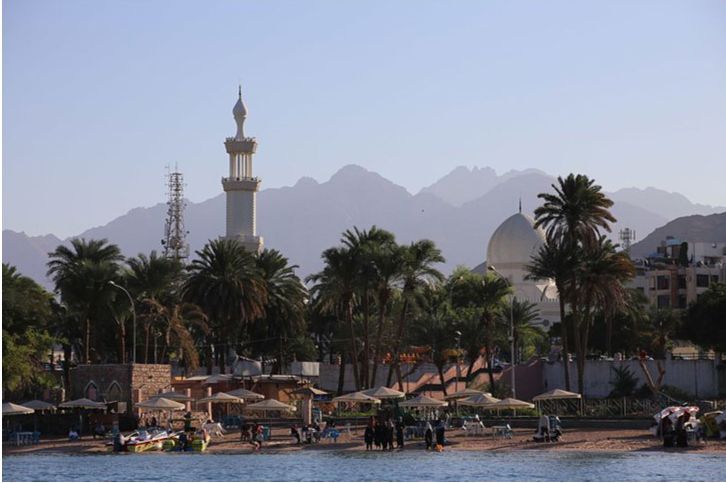
So what does this article on the modern state of Jordan have to do with you?
Nothing, if you never plan to go there. However, it’s always good to learn new things.The purpose of our blog and website are to acquaint you with a country that Daniel talks about and its role in the end of days. We encourage you to make it a matter of prayer as to what Yehovah wants you to do about Jordan.
[1] https://forward.com/culture/161187/circassians-are-israel-s-other-muslims/
[2] https://www.newstatesman.com/politics/2014/08/why-britain-created-monarchies-middle-east
[3] https://en.wikipedia.org/wiki/Interregnum_(Transjordan)#CITEREFRudd1993
[4] https://www.jewishvirtuallibrary.org/the-history-of-modern-jordan
[5] Clea Lutz Bunch, “Balancing Acts: Jordan and the United States During the Johnson Administration,” Canadian Journal of History 41.3 (2006)
[6] https://en.wikipedia.org/wiki/History_of_Jordan#cite_note-31
[7] https://en.wikipedia.org/wiki/History_of_Jordan
[8] https://www.jewishvirtuallibrary.org/the-history-of-modern-jordan
[9]Yoav Alon, The Making of Jordan: Tribes, Colonialism and the Modern State, (I. B. Tauris & Co., Ltd, 2007), 9.
[10] https://www.jewishvirtuallibrary.org/the-history-of-modern-jordan
[11]Alon, Making of Jordan, 6.
[12] Alon, Making of Jordan, 3.
[13] Ibid., 1.
[14] Ibid, 8.
[15] “Population stands at around 9.5 million, including 2.9 million guests”. Jordan Times. 2016-01-30. Retrieved 2019-11-06
[16] “The World Fact book – Jordan”. CIA World Factbook. Retrieved 11 December 2016.
[17] https://en.wikipedia.org/wiki/Demographics_of_Jordan#Refugees
[18] “World Population Prospects – Population Division – United Nations”. esa.un.org.
[19] “Department of Statistics”. dosweb.dos.gov.jo. Retrieved 2018-02-14.
[20] “Jordan tops list of refugee-host countries — Amnesty”. Jordan Times. 2016-10-04. Retrieved 2018-01-30.
[21] Luck, Taylor (21 April 2013). “In Jordan, tensions rise between Syrian refugees and host community”. The Washington Post. Retrieved 2014-04-25.
[22] Black, Ian (31 July 2012). “Jordan jitters over swelling Syrian refugee influx”. The Guardian. Retrieved 7 April 2014
[23] Oddone, Elisa (2014-03-26). “New refugee camp in Jordan ready to host more Syrian refugees”. Al Bawaba. Retrieved 7 April2014.[dead link]
[24] “Jordan profile – Overview”. BBC. 18 November 2012. Retrieved 11 December 2016.
[25] Ministry of Education – Hashemit Kingdom of Jordan”. www.moe.gov.jo. Retrieved 2018-02-13.
[26] https://en.wikipedia.org/wiki/Demographics_of_Jordan#cite_note-15
